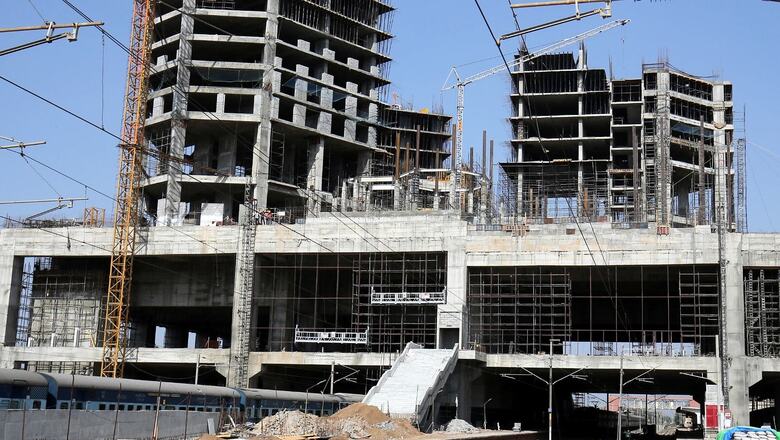Infra Vaani | Covid-battered Economy Needs a Booster Dose. Budget 2022 Must Invest in Infrastructure

views
When Finance Minister Nirmala Sitharaman presents her fourth budget on February 1 amid a third wave of COVID-19 sweeping India, there will be expectations galore from this penultimate full budget of the second term of Prime Minister Narendra Modi. There will be populist temptations, reform imperatives, growth necessities, push for distributional equity and budgetary constraints.
But despite the chaos and confusion of the pandemic-led ‘New Normal’, there is critical need for faster and inclusive growth coupled with substantially enhanced ‘ease of life’ for citizens both rural and urban and ‘ease of business’ for engines of growth.
As such, the big picture has to remain focused on becoming a $5 trillion economy by FY2025 from the current $3.2 trillion. The goal is audacious, roadblocks humongous, but not reaching the summit is not an option.
The big question is—which route to take to the summit?
Quite naturally, multiple efforts from various directions are needed but none more important than massive investment in infrastructure along with critical structural reforms at the planning, execution and delivery front.
And here infrastructure must subsume physical, social and the digital.
Why Infra Push is Necessary
One can ask why infrastructure. One, for India to clock year-by-year double-digit growth to enable the economy to catapult to $5 trillion by 2025 and gallop to $10 trillion by 2035, eliminating the infrastructure deficit is most critical to attainment of the goal.
Two, body blow inflicted by the pandemic has bruised and battered economic growth. Private sector investments continue to languish, and private consumption is yet to reach pre-pandemic levels. Omicron-led third wave of COVID-19 brings more headwinds. In such a situation, government-led infrastructure sector investment will pump-prime the economy.
Three, during the past two years of COVID-19, countries, both developed and developing, unleashed massive investments, including in infrastructure, to bring economies back to rails. Despite some broad-based reforms, India has so far been conservative on the stimulus push. It is time for infra to give growth a leg up, putting fiscal and inflation fears in abeyance, temporarily.
Four, macro economists concur that during downturn faster infrastructure investment is the remedy for the economy. Its direct contribution to employment, construction and materials apart, infrastructure push has a strong multiplier-effect — 2.5-4 times — on the economy.
Five, empirical evidence abounds that “for an economy in distress, infrastructure push is the right nostrum”. “New Deal” of US President Roosevelt, infra-mounted growth of Japan and South Korea in the second half of last century and the unending dream-run of Chinese economy are cases in point where infra push led to massive GDP push with concomitant reduction in absolute poverty.
If that be the case, my singular wish from the finance minister is: infrastructure, infrastructure and more infrastructure.
And this author believes his wishes are synchronous with the audacious infrastructure agenda of the Modi government, re-emphasised in the last Budget. The $1.5 trillion National Infrastructure Pipeline (NIP) first announced in 2019 increased the project basket from 6400 to 7400. This ‘New Deal of India’ is more ambitious than the infra rejuvenation plan of US President Biden. There are many other aspects of the government’s big, bold infra push. A professionally managed Development Finance Institution (DFI) to act as provider, enabler and catalyst for infra development with a target of Rs 5 lakh crore loan book in three years is a defining one.
And, the ambition just got bigger with Rs 100 lakh-crore Gati Shakti, aimed to cut the logistics cost for infrastructure projects by ensuring different ministries work in a coordinated manner. AMRUT (Atal Mission for Rejuvenation and Urban Transformation), Smart Cities, massive focus on urban transport, Swachh Bharat 1.0 and 2.0, Jal Jeevan Mission, Pradhan Mantri Urban and Rural Awas Yojana are few among the many pieces of the infra jigsaw puzzle.
Every year the schemes multiply, and outlays increase. It is now time to walk the talk.
The Prime Minister rightly says, “We have to work on cent percent mode”. But are we?
Focus Areas for Budget 2022
Amid cacophony of big and bigger, what is the performance on the ground?
First, border infrastructure has been ramped up, from all-weather roads, tunnels, railways, airstrips and helipads to projects of critical and strategic importance to India’s Act East Policy. Budget 2022, however, should make full allocation to complete all such projects in the next two years, including 20 projects costing Rs 75,000 crore to connect capitals of eight northeastern states and their tier-2/3 cities with operational rail network.
Two, highways and expressways have been a priority for NDA governments—the current government has scaled up the speed of execution. Appreciable achievements, but the pendulum has swung too far in favour of highways and against railways. It is time for twin-fold policy reboot: first, instead of constructing more and faster highways at breakneck speed, improve the productivity of existing stretches and encourage large-scale creation of electric vehicle charging infrastructure for fast-growing needs of personal and commercial vehicles. Second, it is time to look beyond highways and pay accelerated attention to high-speed rail (passenger) and semi high-speed rails (freight).
Three, the record of the present government on creating rail-based urban transport infrastructure (metro rail) is praiseworthy with 18 cities running 800-km operational network, 1000 km-plus construction at various stages in 24 cities and another 1000 km in the planning stage. This planning and pace of construction is next only to China and in sync with cities being the engines of growth. It also targets pollution reduction in cities, making them ready for 600 million urban dwellers by 2030. The Metro Rail Policy, 2017 has been a great enabler, giving primacy to economic internal rate of return (EIRR) as against earlier unattainable financial internal rate of return (FIRR) for sanction of metro rail projects.
While this is laudable, there is a problem: metro rail is costly to construct and operate, is not meant for all cities, and it still lacks multi-modal and last-mile connectivity in cities where it is operational. Efficient green buses, intermediate-transport and non-motorised transport infrastructure are critical needs. While provisioning for these, the Budget has to ask for completion of sanctioned metro rail and other urban transport projects within strict cost and time limit.
Fourth, Indian Railways (IR) stands out as the biggest laggard. Even before COVID-19, Railways was facing existential crisis, losing passengers to road and air while freight to highways, ballooning staff and pension costs, and the heavy burden of running schools, colleges and hospitals. After COVID-19, this crisis has exacerbated. Time is ripe for meaningful, doable and implementable reforms.
What should Budget 2022 provide? First, clear pathways to complete jinxed Eastern and Western Dedicated Freight Corridors; they are running a decade late with 100 per cent cost escalation. Second, desist from announcing more freight corridors. Third, announce 5000-km high-speed rail (350 kmph) intercity passenger corridors to be completed in 10 years. Ever since we have been talking about Ahmedabad-Mumbai HSR corridor, China has operationalised 40000-km HSR network, bringing its cities together.
Fourth, convert 10000 km of existing route to semi high-speed Rail (250 kmph) to improve line productivity. Fifth, go aggressively for the low hanging fruit—modern signalling and communication. Sixth, get practical with station modernisation, start with creating 10 global best stations before thinking bigger. Seventh, immediately stop the undesirable plan of mothballing and merging listed Railway PSUs; instead think laterally, merge railway zones into cohesive business units, hive off 19th century legacy of schools, colleges, hospitals and sell factories manufacturing coaches, wagons and locomotives. A bus operating company does not manufacture buses, even metro rail systems in India buy best metro cars and do not manufacture them.
This is first in a two-part series on how Budget 2022 can deliver on infrastructure promise and growth.
The author is an infrastructure expert and President, Advisory Services, BARSYL Limited. The views expressed in this article are those of the author and neither represent the stand of this publication nor the author’s company.
Read all the Latest Opinions here




















Comments
0 comment